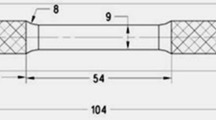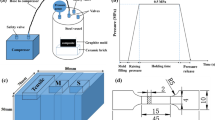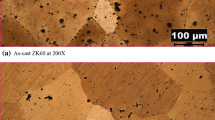Abstract
We analyzed the wear characteristics according to dispersion level of MWCNT in YD-128/MWCNT composite. Specimens for this study were fabricated using mechanical stirrer after blending of YD-128 and MWCNT. To change the dispersion level, the mixture of YD-128/MWCNT was stirred using mechanical stirrer during different times, such as, 15, 30, 60, and 120 minutes. Because the direct measuring of dispersion level is difficult in the case of solid composite, we suggest an indirect method for checking qualitatively the dispersion level as follows. Firstly, using the AEH (asymptotic expansion homogenization) in-house code, we analyzed numerically the mechanical stiffness of composite using RVEs (representative volume elements) which are modeled with different dispersion level. According to the numerical results of RVEs, we verified that the mechanical stiffness is higher as the dispersion degree is better. Then, through the experimental tensile test of the fabricated specimens using UTM, we obtained that the mechanical stiffness is higher as the stirring time is longer. Consequently, we could ensure that the dispersion degree of the fabricated specimens is better as the mechanical stirring time is longer. Finally, we assessed the wear test using abrading machine with fabricated specimens. We confirmed that the abrasion loss is decreased according to the increasing of dispersion degree in the case of YD-128/MWCNT composites.
Similar content being viewed by others
References
I. M. Lee, I. J. Jin, C. Y. You, G. S. Lee, H. W. Kim and H. J. Hwang et al., Nanomaterials: Carbon nanotube, Daeyounsa, Seoul (2011).
S. R. Bakshi, D. Lahiri, R. R. Patel and A. Agarwal, Nanoscratch behavior of carbon nanotube reinforced aluminum coatings, Thin Solid Film, 518(6) (2010) 1703–1711.
H. J. Hwang, S. L. Jung, K. H. Cho, Y. J. Kim and H. Jang, Tribological performance of brake friction materials containing carbon nanotubes, Wear, 268(3–4) (2010) 519–525.
V. Singh, R. Diaz, K. Balani, A. Agrawal and S. Seal, Chromium carbide-CNT nanocomposites with enhanced mechanical properties, Acta Materialia, 57(2) (2009) 335–44.
C. Wang, T. Xue, B. Dong, Z. Wang and H. L. Li, Polystyrene-acrylonitrile-CNTs nanocomposites preparations and tribological behavior research, Wear, 265(11–12) (2008) 1923–1926.
H. Wang, J. Feng, X. Hu and K. M. Ng, Tribological behaviors of aligned carbon nanotube/fullerene-epoxy nanocomposites, Polymer Engineering & Science, 48(8) (2008) 1467–1475.
Y. S. Jeon, J. Y. Byun and T. S. Oh, Electrodeposition and mechanical properties of Ni-carbon nanotube nanocompsite coatings, Journal of Physics and Chemistry of Solids, 69(5–6) (2008) 1391–1394.
Y. S. Zoo, J. W. An, D. P. Lim and D. S. Lim, Effect of carbon nanotube addition on tribological behavior of UHMWPE, Tribology Letters, 16 (2004) 305–309.
H. Cai, F. Yan and Q. Xue, Investigation of tribological properties of polyimide/carbon nanotube nanocomposites, Materials Science and Engineering: A, 364(1–2) (2004) 94–100.
S. Kanagaraj, F. R. Varanda, T. V. Zhil’tsova and M. S. A. Oliveira, Mechanical properties of high density polyethylene/carbon nanotube composites, Composites Science and Technology, 67(15–16) (2007) 3071–3077.
S. Kedem, J. Schmidt, Y. Paz and Y. Cohen, Composite polymer nanofibers with carbon nanotubes and titanium dioxide particles, Langmuir, 21(12) (2005) 5600–5604.
Y. S. Song and J. R. Youn, Influence of dispersion states of carbon nanotubes on physical properties of epoxy nanocomposites, Carbon, 43(7) (2005) 1378–1385.
T. McNally et al., Polyethylene multiwalled carbon nanotube composites, Polymer, 46(19) (2005) 8222–8232.
F. H. Gojny, J. Nastalczyk, Z. Roslaniec and K. Schulte, Surface modified multi-walled carbon nanotubes in CNT/epoxy-composites, Chemical Physics Letters, 370(5–6) (2003) 820–824.
O. K. Park, T. Jeevananda, N. H. Kim, S. Kim and J. H. Lee, Effects of surface modification on the dispersion and electrical conductivity of carbon nanotube/polyaniline composites, Scripta Materialia, 60(7) (2009) 551–554.
S. J. Wang, Y. Geng, Q. Zheng and J. K. Kim, Fabrication of highly conducting and transparent graphene films, Carbon, 48(6) (2010) 1815–1823.
M. Kaempgen, G. S. Duesberg and S. Roth, Transparent carbon nanotube coatings, Applied Surface Science, 252(2) (2005) 425–429.
L. Pinho-da-Cruz, J. A. Oliveira and F. Teixeira-Dias, Asymptotic homogenization in linear elasticity. Part I: Mathematical formulation and finite element modeling, Computational Materials Science, 45(4) (2009) 1073–1080.
J. A. Oliveira, J. Pinho-da-Cruz and F. Teixeira-Dias, Asymptotic homogenization in linear elasticity. Part II: Finite element procedures and multiscale applications, Computational Materials Science, 45(4) (2009) 1081–1096.
M. Halusk, M. Hulman and M. Hirscher, Hydrogen storage in sonicated carbon materials, Applied Physics A, 72(2) (2001) 129–132.
N. Pierard, A. Fonseca, Z. Konya, I. Willems, G. V. Tendeloo and J. B. Nagy, Production of short carbon nanotubes with open tips by ball milling, Chemical Physics Letters, 335(1–2) (2001) 1–8.
Y. B. Li, B. Q. Wei, J. Liang, Q. Yu and D. H. Wu, Transformation of carbon nanotubes to nanoparticles by ball milling process, Carbon, 37(3) (1999) 493–497.
J. Hilding, E. A. Grulke, Z. G. Zhang and F. Lockwood, Dispersion of carbon nanotubes in Liquids, Journal of Dispersion Science and Technology, 24(1) (2003) 19–41.
P. J. Boul et al., Reversible sidewall functionalization of buckytubes, Chemical Physics Letters, 310(3–4) (1999) 367–372.
J. Liu et al., Controlled deposition of individual singlewalled carbon nanotubes on chemically functionalized templates, Chemical Physics Letters, 303(1–2) (1999) 125–129.
K. D. Ausman, R. Piner, O. Lourie and R. S. Ruoff, Organic solvent dispersions of single-walled carbon nanotubes: Toward solutions of pristine nanotubes, Journal of Physical Chemistry B, 104(38) (2000) 8911–8915.
D. B. Mawhinney, V. Naumenko, A. Kuzentsova and J. T. Yates Jr., Infrared spectral evidence for the etching of carbon nanotubes: Ozone oxidation at 298 K, Journal of American Chemical Society, 122 (2000) 2383–2384.
H. Ago et al., Work functions and surface functional groups of multiwall carbon nanotubes, Journal of Physical Chemistry B, 103(38) (1999) 8116–8121.
S. Balasivanandha Prabu, L. Karunamoorthy, S. Kathiresan and B. Mohan, Influence of stirring speed and stirring time on distribution of particles in cast metal matrix composite, Journal of Materials Processing Technology, 171(2) (2006) 268–273.
Author information
Authors and Affiliations
Corresponding author
Additional information
Recommended by Associate Editor Moon Ki Kim
Young-Sam Cho received his B.S., M.S., and Ph.D. degrees in Mechanical Engineering from KAIST in 1997, 1999, and 2004, respectively. He is currently an associate professor at Wonkwang University, Korea. His research interests include computational mechanics, tissue engineering, and surface modification.
Rights and permissions
About this article
Cite this article
Choi, G.P., Sohn, D., Woo, C.H. et al. Qualitative verification of the dispersion level in nano-composite and its application to YD-128/MWCNT composite to assess the wear characteristics with respect to the dispersion level. J Mech Sci Technol 27, 3131–3138 (2013). https://doi.org/10.1007/s12206-013-0833-0
Received:
Revised:
Accepted:
Published:
Issue Date:
DOI: https://doi.org/10.1007/s12206-013-0833-0




